What Is An Ecommerce Website?
Ecommerce stands for “electronic commerce.” Ecommerce websites are built to connect shoppers to products or services for trading online. On the most basic level, they provide everything we need for online shopping. They work like this:
- A business builds the website and lists the products or services they sell, along with prices. (There are a ton of ecommerce platforms out there that make it easier to start your online business.)
- A customer finds the website, then buys goods and services. When they’ve decided they’re done online shopping, they move to the checkout phase.
- Following the website’s checkout process, the buyer provides the necessary payment and shipping information.
- The ecommerce website sends the payment information through a payment processor that validates the payment and collects the funds.
- The seller then ships the order to the customer or sends the digital product immediately via email.
As simple as the process seems on the surface, though, there are many moving parts to coordinate for all online purchases. All online stores rely on the same technology to run. That’s what I’ll outline for you here – so that you can set up a high-quality ecommerce website that customers will come to again and again.
If you’re thinking about starting an ecommerce business of your own or just want to learn ecommerce, start here. Once you get the basics out of the way, you can move on to learning about ecommerce business models. From there, you’ll be able to set up your online store. Once it’s up and running, you’re an official ecommerce business owner.
How Do Ecommerce Websites Work
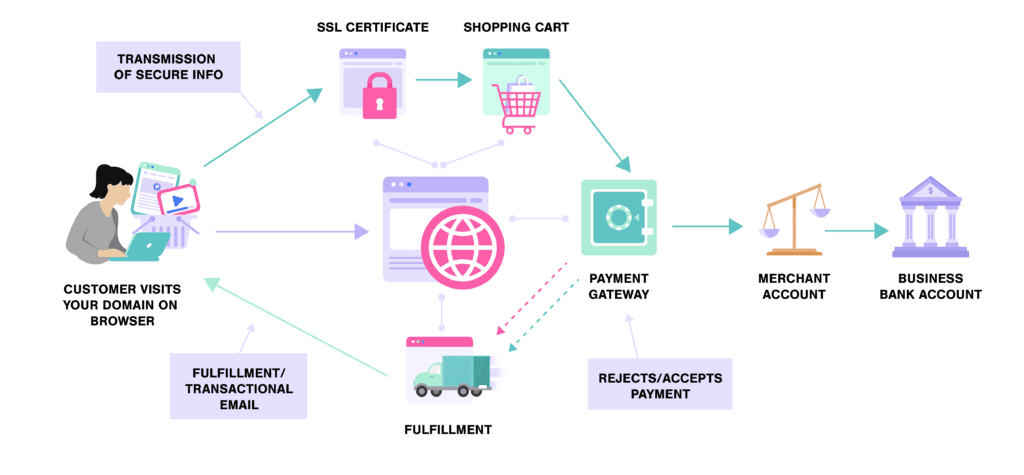
- Ecommerce Website Platform: The framework or tool your website is built with. Examples include Shopify, BigCommerce, Wix, etc.
- Shopping Cart: The part of your website that facilitates checkout and product purchase.
- SSL Certificate: The technology that keeps your website secure for financial transactions.
- Payment Gateway: The technology that accepts payment information from customers and approves or declines payment based on whether the funds are available.
- Payment Processor: The company that manages the credit card transaction – the third party between the customer and you as the merchant.
- Business Bank Account: The checking account funds go to after transactions are complete and processed through the merchant account.
- Fulfillment: The process to warehouse and ship packages to customers.
Different Types Of Ecommerce Website Hosting
Not all online store builders are the same. If you have zero dev skills, you’d want to use a SaaS platform like Shopify or BigCommerce.
On Premise
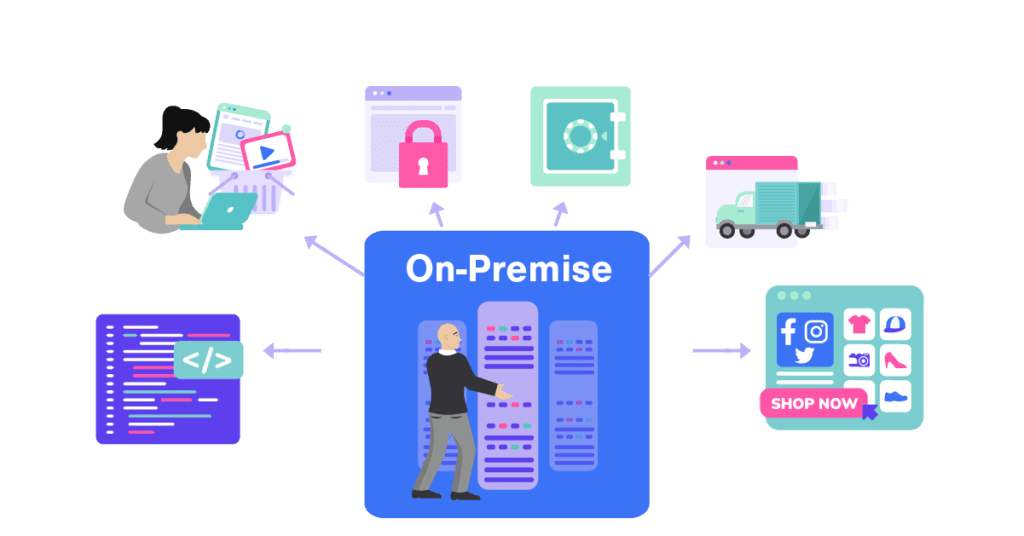
On-premise hosting means that a business keeps all the hardware and software for its website in-house – typically somewhere with the company’s physical office location. This approach is expensive because the business must purchase and maintain all the servers, firewall, operating systems, software licensing, etc. They must maintain backups and upgrades. If your company doesn’t have an IT team on staff or the money to hire one, on-premise is not a good choice for you.
Headless Ecommerce
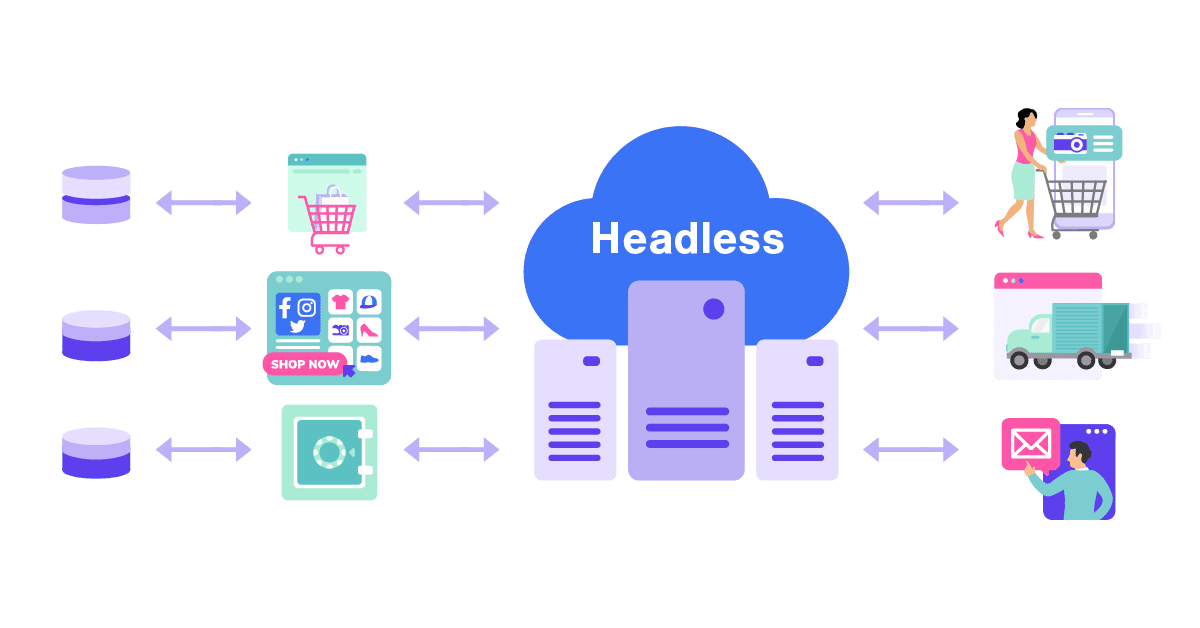
Headless ecommerce separates the front and back end of an ecommerce application. This approach provides brands with more flexibility over the customer experience. There’s more freedom to build whatever you want. Headless commerce requires using APIs, engagement tools, experience managers, and an IT team. As such, smaller businesses tend to opt for other solutions.
SaaS Ecommerce
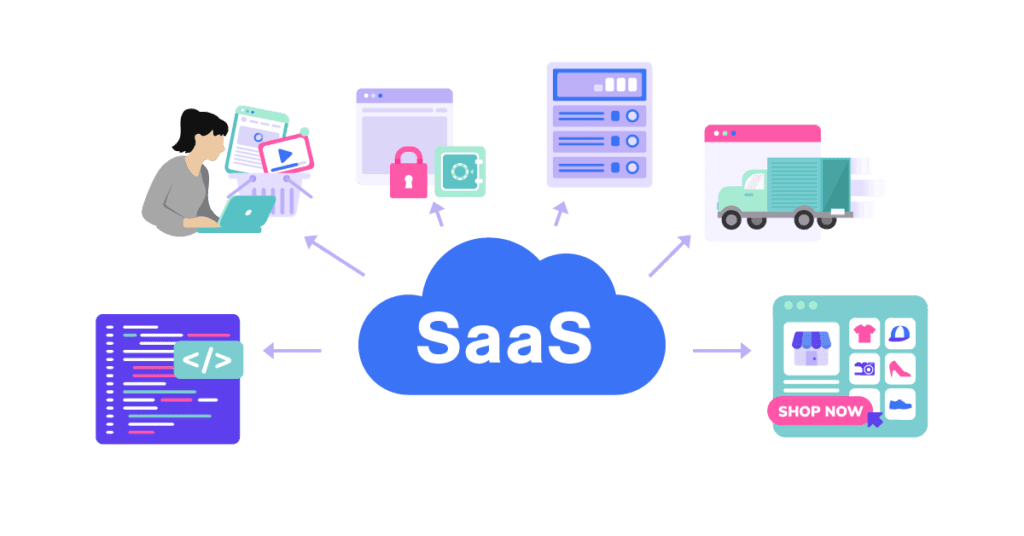
SaaS, or software as a service, is a popular business model. Not just for ecommerce platforms, SaaS enables businesses to get access to all the software they need without having to be tied to the machine they’re using. SaaS solutions are accessible from any device where there’s an internet connection.
When it comes to SaaS ecommerce, many popular platforms are available including Shopify, BigCommerce, and Wix. These solutions take care of everything for the customer. There’s no need to worry about web hosting, software licenses, domain name, SSL certificate, etc. In exchange for a monthly or annual fee, the service provider handles all of the technical stuff. It’s an affordable way for small businesses that do not have an IT team to handle ecommerce.
Ecommerce Websites Examples
Common types of ecommerce websites include:
Single Brand Website
This is a website that only sells products or services from a single company or person. For example, Brook’s Running only sells shoes they make.
Online Retailers
This is where brands like Best Buy, Macy’s, and Bath and Body Works fit in. They sell multiple products from a variety of brands.
Affiliate websites
These websites are built around a product, service, or group of products and services. They include links to other businesses. When website visitors make purchases through one of those links, you’ll earn a commission from the sale.
Marketplaces
Aside from major players like Amazon and eBay, platforms like Etsy, Newegg, and Jet can be great for ecommerce businesses in specific niches.
These can be used to sell both goods and services, including digital products like online courses. The one that will work best for your ecommerce store depends on what you’ll be selling and the business model you’ll use.
Main Features of Ecommerce Websites
As you start to learn about ecommerce, you don’t want to get bogged down with too many details on buying and selling. That’s why we created a comprehensive website checklist. However, once you’re more familiar with ecommerce and are ready to set up your online store, there are a few features your website should include for ecommerce functionality. Tailor your ecommerce website to include:
User-Friendly Features
When people shop online, they want to quickly and easily find whatever they are looking for. If they can’t, they’re not likely to stick around long – and if they don’t do that, you definitely won’t get them to make an online purchase. Ecommerce sites that focus on the user experience (UX) are more successful than those that do not. What should your ecommerce website design include?
Easy Navigation
Clear navigation menus that make it easy to browse products by category. Place the menus in an easy-to-find place, either on the side of the page or across the top. Keep them consistent across every page.
Product Filters
Product filters so that shoppers can sort through product offerings to find what they want quickly. For example, allow customers to filter by price, size, color, product type, brand, style, etc.
Product Availability
Have you ever found something you were looking for, only to discover later it was out of stock? That’s a frustrating experience for your target audience. Do they purchase something else similar? Visit other online stores to find the particular item? Wait for the item to come back into stock?
To combat this, include product availability information for each of your products in a prominent location on the product page. If any products do go out of stock, have information about when you can expect them to be available again.
Clear Cart and Checkout Buttons
To encourage conversions and higher online transaction volume, make sure your “add to cart”/ “buy now” buttons, and checkout buttons are clear. When a customer clicks to visit their cart, make sure they can see all the essential details such as:
- Item names
- Price
- Product quantity
Make it quick and easy to remove items or change the quantity from within the cart page. Most importantly, allow your customers to save their cart and come back to it later.
Multiple Payment Options
The more payment options you offer, the better it is for you and your customer experience. This way, they have the flexibility to use their chosen payment method and can place their order in just a few clicks. Popular options include:
- PayPal
- Google Pay
- Apple Pay
- Amazon Pay
- Shop Pay (Shopify)
Each of these options will accept popular credit and debit cards like Visa and Mastercard. If you also want customers to be able to pay with American Express or Discover, double-check that at least one of the payment options you offer allows for those cards.
Customer Service and Contact Options
Your customers need to be able to reach you with questions and concerns about their orders. If you’re not ready to invest in online support ticketing tools or live chat, you should at the very least have:
- A dedicated email address that’s prominently displayed
- Links to your social media accounts so people can reach you there
- Self-service options to make it easy for customers to initiate a return or exchange request
- Company phone number and address in the footer
Important Website Content
Your potential customers will have questions. Make certain information easy to find.
Order Processing Timeline
How long does it take you to pack and ship an order after it is placed? Give an estimate but allow yourself plenty of time to process the order. Most companies ship orders within 1 to 5 business days from the date of the order.
Do orders placed before a specific time of day get shipped the same day? If so, make sure that time is clearly displayed.
Shipping Policies
What does your standard shipping look like? Do you offer expedited shipping? What carriers do you use? Do you ship internationally? Do you cover return shipping costs?
Return Policies
Do you accept product returns? If so, what are the terms? 30 days? 60 days? Is money refunded or store credit offered? Spell out these policies to help guide people in their shopping choices.
Privacy Policy
Store owners are legally required to have a privacy policy on their ecommerce site. This document outlines how your ecommerce business will collect, store, protect, and use any personal information internet users provide. This includes information such as:
- Name
- Date of birth
- Addresses (Email, physical, and shipping)
- Payment details
- Location (IP address, geolocation, etc.)
Beyond detailing how the company uses the information, it covers how your commerce business will meet its legal obligations and how the people sharing their data can get recourse if you fail to meet your responsibilities.
Most countries have laws in place that require you to have a privacy policy if you collect any kind of personal information from your users – whether you’re working in the ecommerce industry or not. At this time, the U.S. does not have federal privacy legislation. However, the state of California has the California Online Privacy Protection Act (CalOPPA) and the California Consumer Privacy Act (CCPA). If your online shop sells goods and services to people in California, you must comply with that law.
The European Union (EU) has strict privacy laws, too. If you are selling to customers in the EU, you must comply with the General Data Protection Regulation (GDPR) even if you operate your e-business in the United States.
Many third-party services require you to have a valid privacy policy on your website to comply with their terms of service. If you use Google Analytics and other marketing tools, you’ll be required to have one.
For the best results, hire a legal team to help you develop your privacy policy.
Terms of Service
In addition to a privacy policy, your e-commerce site plan should also have a Terms of Service page. It’s what sets the rules for your using website, and ecommerce sites are no different.
There’s no legal requirement for defining terms and conditions like there is with a privacy policy. Despite this, it’s still a good idea to have one. Why?
The terms and conditions of your website can limit liability if a customer decides to take you to court. Plus, it can help protect your rights to the content on your website.
If you ever find yourself in a legal battle, the court will look at your terms and conditions to determine the contract between you and the customer. If you want it to hold up in court, you may want to have a legal team handle this too.
Do not copy the terms and conditions of another site. You can use sites similar to yours to help guide you.
Frequently Asked Questions
Always include a frequently asked questions page where customers can find the answers they’re looking for. If you find that your customer service team (even if that’s only you) is constantly having to answer the same question over and over, it’s time to add it to your FAQ section. If the information is already on your ecommerce website, consider adjusting its location to make it easier to find.
Examples to include:
- Do you offer free shipping?
- How fast can I expect to receive my order?
- What do I do if I need to return or exchange my order?
- What if I have a question about my order?
Mobile-Friendly Website
More than half of all website traffic comes from mobile users. As such, you shouldn’t count on your customer being on a desktop computer when they’re navigating your website. Build your ecommerce website with responsive design to be sure you cover your mobile commerce bases. This ensures that no matter what mobile devices a customer uses to complete online transactions, they can do so easily.
A responsive design automatically adjusts your website’s core features – navigation, images, buttons, etc. so that it fits comfortably on a smartphone or tablet screen. Failure to account for this will hurt your ecommerce website since Google considers this a ranking factor. If it’s not mobile optimized, your website won’t rank as high in the search engine, no matter how well you’re doing with your other marketing efforts.
High-Quality Photos
A picture is worth a thousand words, and you want your ecommerce website to echo this sentiment. Successful ecommerce stores use high-quality photos to display their products. High-resolution images are great, but their large file size can dramatically slow down your website speed. That’s why you should start with a web-optimized version and allow your customers to click to see the full image.
Brick and mortar stores have lots of visual aids throughout the store. And they have the added advantage of allowing customers to touch and feel the products. To compete, your online storefront has to have more than a single photo of each product you offer.
High-Quality Videos
Whenever possible, use video to demonstrate your products. This is helpful for products that people want to see and feel before they buy. If a photo is worth 1,000 words, imagine the impact of video.
User Ratings and Reviews
Add user ratings and reviews to as many of your products as you can. User-generated reviews are read and appreciated by online shoppers. When you provide a setup for user reviews to be submitted and displayed to website visitors, you’ll provide helpful information for other customers. And they’ll thank you for it.
Trust Symbols
Photo credit: Trustpilot
Your ecommerce website, especially when it is new, needs to have plenty of trust symbols. Until customers become familiar with your brand, these symbols will help foster a connection. Trust badges legitimize your website. Research shows that 98% of consumers surveyed found at least one type of trust signal that increased their purchase likelihood.
Add symbols like:
Guaranteed Safe and Secure Checkout
This helps reinforce your website’s security to help customers know their payment information is safe.
Free Shipping and Free Returns
Of course, you should only use this badge if you offer both free shipping and free returns. If not, it will be false advertising and upset your customers.
Accepted Payment Badges
This is a quick and easy way to show all the payment methods you accept so that people can choose their preferred payment method. These trusted brand names will help you establish trust with your audience.
Third-Party Endorsements
If you have any third-party endorsements, such as a Better Business Bureau accreditation or Google Reviews, add these to your website.
Coupons and Special Offers
Customers adore special offers. Use email marketing and social media to provide exclusive coupons and special offers to those already engaged with your brand. Offer a percent discount, free shipping at a certain threshold, or another limited-time offer.
Upselling and Cross-Selling
To increase sales, offer customers the option to get a better price when they buy more. Upselling happens when you raise a customer’s order value by offering additional services or encouraging them to purchase an upgraded product or service.
Alternatively, you can use cross-selling, which is when you add offers of items that either supplement or complement your customer’s purchase. For instance, if a customer purchases a phone case, you can cross-sell screen protectors, chargers, and other accessories.
Wishlist
If you have a lot of products, consider adding a wish list function to your site. This will allow your customers to make a list of things they’d like to order from you. Plus, they can share that list with friends and loved ones to make gift-giving easier.
Must Read Ecommerce Resources:
- Shopper Approved Reviews: Right for Your Ecommerce Site?
- How to Sell Your Ecommerce Business for The Best Value
- How to Sell Your Shopify Store + Get The Best Value
Building An Ecommerce Website
When it comes to building an ecommerce website, you have several options to choose from.
When deciding between ecommerce solutions, the platform you choose has a significant impact on your workflow. Some platforms have features built-in to all eCommerce websites. Others make you purchase additional plugins to get the features you need. Some platforms include all the technical stuff, while others let you control all of it. Some you can even use for free.
Choose Your Platform: Self-Hosted vs. SaaS
If you need control over the technical aspects of your store, you’ll want a self-hosted ecommerce platform. With this option, you’ll purchase your own web hosting, domain name, and SSL certificate. You’ll install the ecommerce software, too. You can use open-source software if you want access to the source code for modification.
SaaS platforms come with a monthly rate. That monthly rate includes your web hosting, domain name, SSL certificate, and the cost of the software. Depending on the setup, it can be more cost-effective to use a SaaS solution. If you have to pay monthly for a bunch of extra add-ons, it may not be.
The choice usually comes down to whether you have the knowledge to do it yourself, an IT team in-house, or can hire the support you need on a freelance basis.
Options for a self-hosted ecommerce site include:
WooCommerce on WordPress
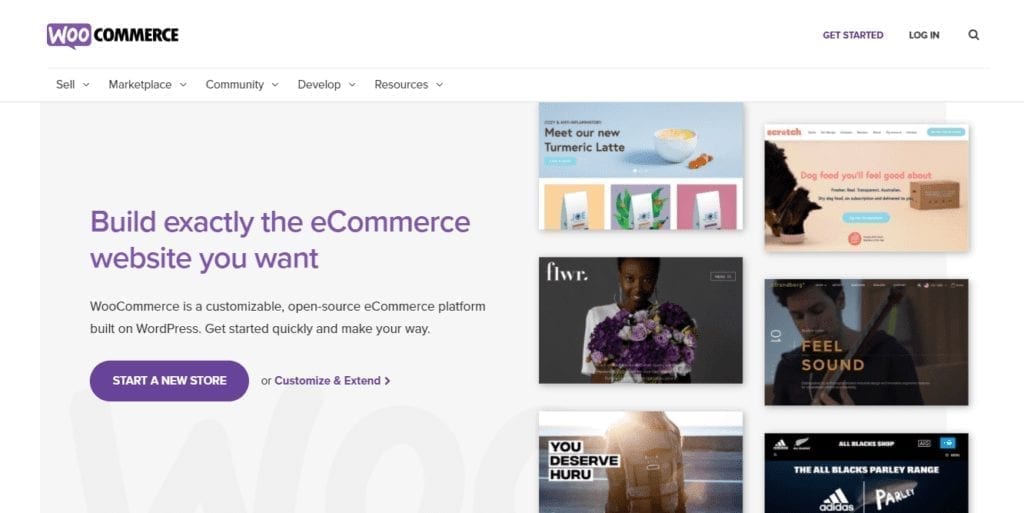
If you want to run an ecommerce business and an affiliate website under one roof, WooCommerce is the best option. WooCommerce is a WordPress plugin that lets you turn any WordPress website into a full online store.
There are a ton of extensions available to add features, like email marketing, payment gateways, and integrations with social media platforms. The plugin itself is free, as is WordPress. But, you may find yourself paying for extensions depending on what features you need.
X Cart
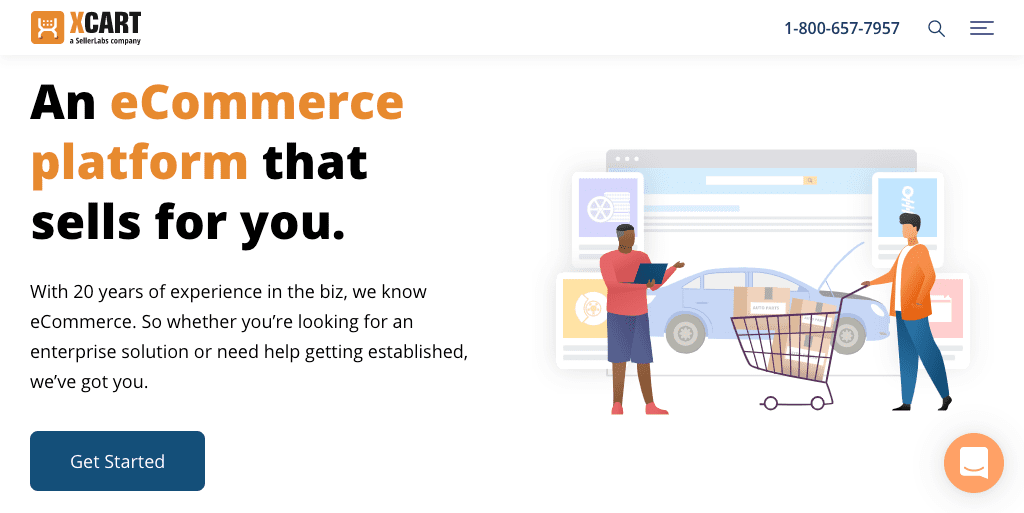
X Cart is a PHP shopping cart. With it, you can track online purchases, inventory, and more. It comes with an impressive list of features, but it’s an expensive option, coming in at $495+ to upgrade. The main selling point is that the license is lifetime – so it’s a one-time fee.
To take full advantage of what this platform has to offer, you’ll need to use HTML and manual coding. There are no transaction fees. If you’re at the enterprise level, it’s worth looking into the enterprise edition.
For the less technical, X Cart offers hosting plans to support their software.
OpenCart
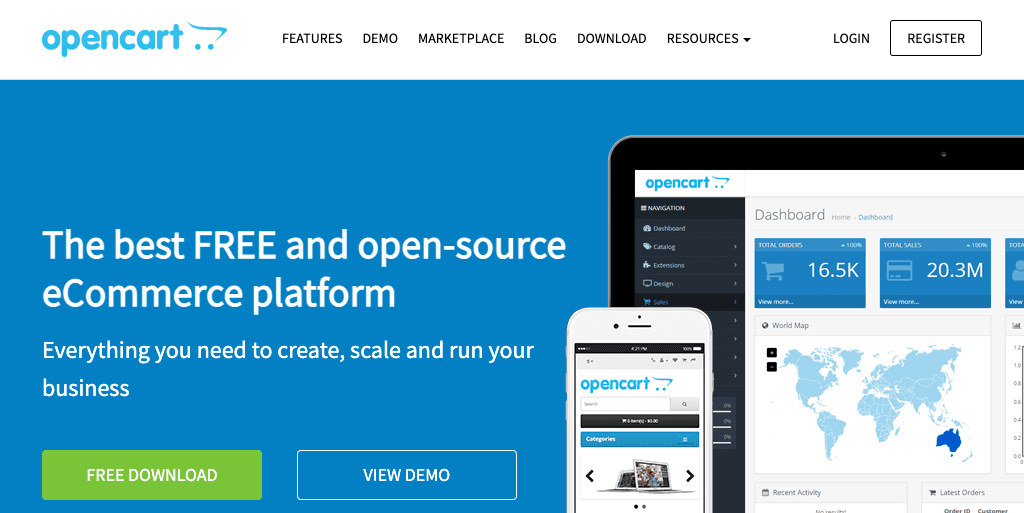
Like WooCommerce, OpenCart is both open-source and free. It’s a great option if you need something that supports multiple languages and currencies. It offers more than 20 payment gateways and eight shopping options.
You can get it up and running without needing to make any changes to the code itself. You can, of course, make edits to customize your online store. With more than 2,700 themes to choose from, you can bet you’ll find something that works well with your branding.
The OpenCart community is highly active, which is a great thing when you find yourself needing support.
Adobe Commerce Community Edition (Formerly Magento Community Edition)
If you want a free and open-source solution that’s not WooCommerce or OpenCart, you may find Adobe Commerce Community Edition to be what you’re looking for. There are plenty of extensions available in the Adobe Commerce Marketplace to add features to your website.
That said, you need to have a decent understanding of the technical side of things. The good news is that because the platform is so popular, there’s a community of partners you can work with. And if you want to improve your skills with Adobe Commerce, you can even take courses at Adobe Commerce U to become a certified professional.
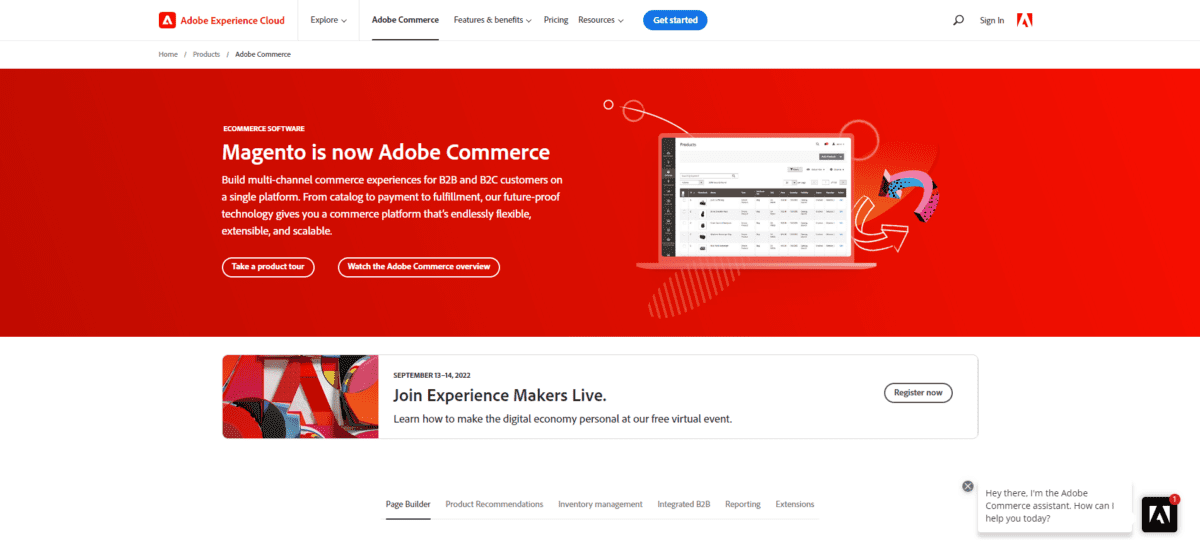
Adobe Commerce (Powered by Magento)
If you’re at the Enterprise level, you can still use Adobe Commerce to power your store. It includes a variety of features to make things easier for you, such as:
- Page Builder
- Content Staging and Preview
- Customer Segmentation and Personalization
- Live Search
- Instant Purchasing
- Product Recommendations
- Merchandising
The headless commerce architecture gives you the freedom and flexibility to take full control of the customer experience.
Options for SaaS include:
Shopify

Shopify is one of the most popular hosted ecommerce solutions on the market today. Pricing starts at $29/month. It’s the best platform when it comes to selling. It’s great for dropshipping, Instagram marketing, and businesses that rely on Facebook Ads. It also works well for businesses that also have a brick and mortar store.
But, it does fall short in search engine optimization (SEO) and performance when compared to other platforms like BigCommerce. Its rigid URL structure means that you’ll need to hire a developer to make changes.
It’s easy for people with no technical knowledge to get started. And if you need help, there are lots of certified partners available. It’s limited in terms of free themes – there are only about 10. And the premium themes will set you back at least $180. But again, there are plenty of options available from third-party developers, so you’ll find something you can make work.
There are a ton of apps to add features to your website. Unfortunately, many of these are paid. When you add a lot of them, your costs will add up quickly.
Check out these other Shopify resources to help you make your decision:
- How Does Shopify Work?
- How to Setup a Shopify Store for Success
- What Shopify Pricing Plans Will Really Cost You
- WooCommerce vs. Shopify
BigCommerce
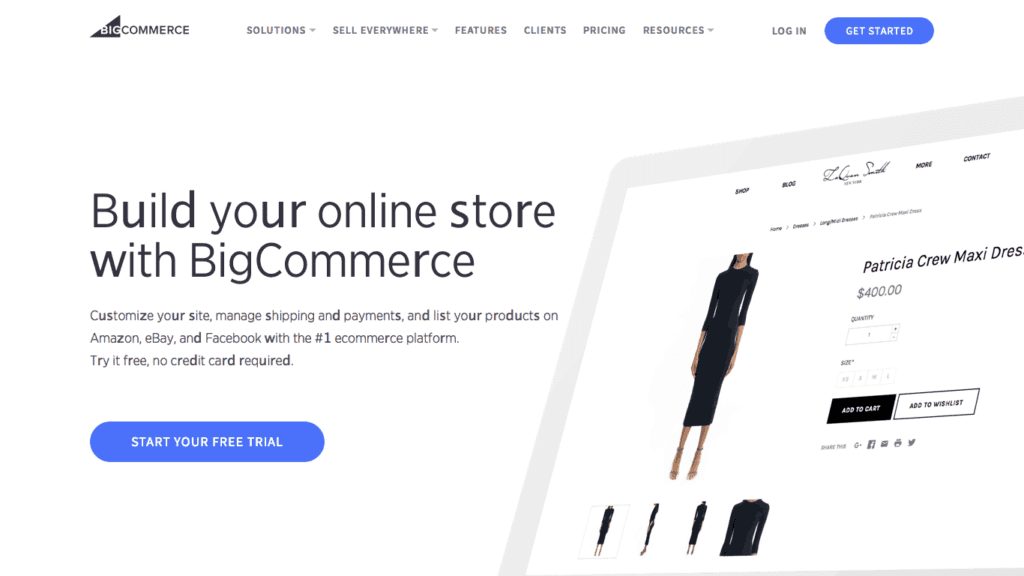
BigCommerce is another popular option and gives Shopify a run for its money. Pricing starts at $29.95/month. We think it’s the best overall platform. It’s easy to use even if you don’t have a technical background. But if you know HTML and CSS, you can easily make adjustments where you need to. It works well for large retail brands and startups. It’s scalable, making it easy to grow with you.
If you’re looking for a free theme, you’ll be disappointed. There are only about seven free options. If you’ve got the budget though, you’ll have a ton of premium templates that take little to no customization to make work. They’re focused on the buyer, which is what you want.
At the lowest pricing point, you’ll get things like unlimited bandwidth, professional reporting, gift cards, and discount codes. If you want things like custom SSL or abandoned cart recovery, you’ll have to upgrade. It’s still an ideal option for stores making less than $50K a year in sales, though. If your store earns more, you’ll need a higher plan. But as the plans increase, the sales limit does, too.
Need help choosing? Take a look at our BigCommerce vs. Shopify comparison.
Wix
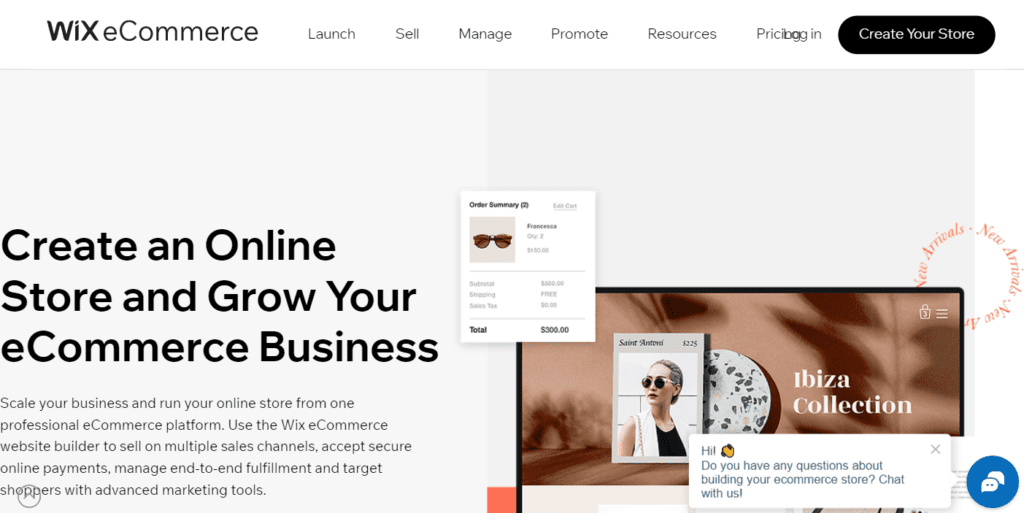
Wix has really surprised us with how far it has come over the past few years. When we first started writing reviews, Wix didn’t even make the cut. And when it did, it still got a poor rating. They’ve really stepped up their game to deliver true value to consumers.
It’s a highly user-friendly platform that’s great for beginners. There’s a drag and drop feature so you can design without ever touching code. And there are more than 70 free themes to choose from.
Now, they offer essential features for any ecommerce site like abandoned cart recovery and multichannel integration. They’ve also added print-on-demand and dropshipping capabilities.
They still have some SEO issues, like the extra string of characters on blog posts and product pages. That’s not ideal, but with a little work, you can still have your Wix sites rank well.
It’s worth noting that the storage space is only 20GB. If you’re primarily selling digital products, you may find that this isn’t enough for you.
See how Wix compares to Shopify.
Shift4Shop

Shift4Shop, formerly known as 3dcart, has been in business since 2001. Pricing starts at $19/month, but you can get the enterprise plan completely free if you use the Shift4Shop payment processing, Shift4. These payment processing fees aren’t public. You have to request a quote. The website mentions the possibility of waived gateway and setup fees.
It includes a website builder (drag and drop for easy design), a shopping cart with multiple customizable checkout options, unlimited products, etc. There are more than 100 free themes to choose from to build your store.
Shift4Shop has a robust set of SEO features, including:
- Customized page titles, H1 headings, and meta tags
- Customizable URL structure
- Schema Markup
- Control over Robots.txt
- And more…
Shift4Shop also includes a built-in blog, and many other tools that make it easy to run your online store. It is an ideal ecommerce platform for many businesses large and small.
Set Your Ecommerce Stores Up for Success
Whether you end up building your own ecommerce business selling business to business (B2B ecommerce), consumer to consumer, consumer to business, or business to consumer (B2C), it’s critical to understand these core principles. Being aware of how online selling works at this level will make it easier to operate your commerce business.